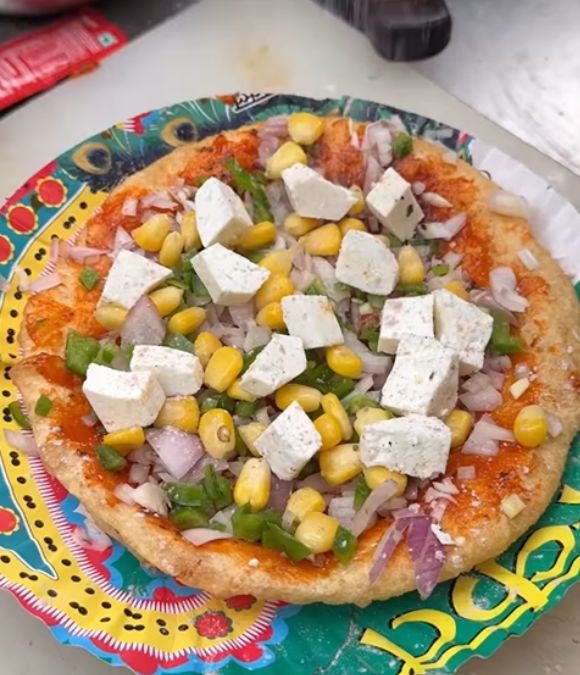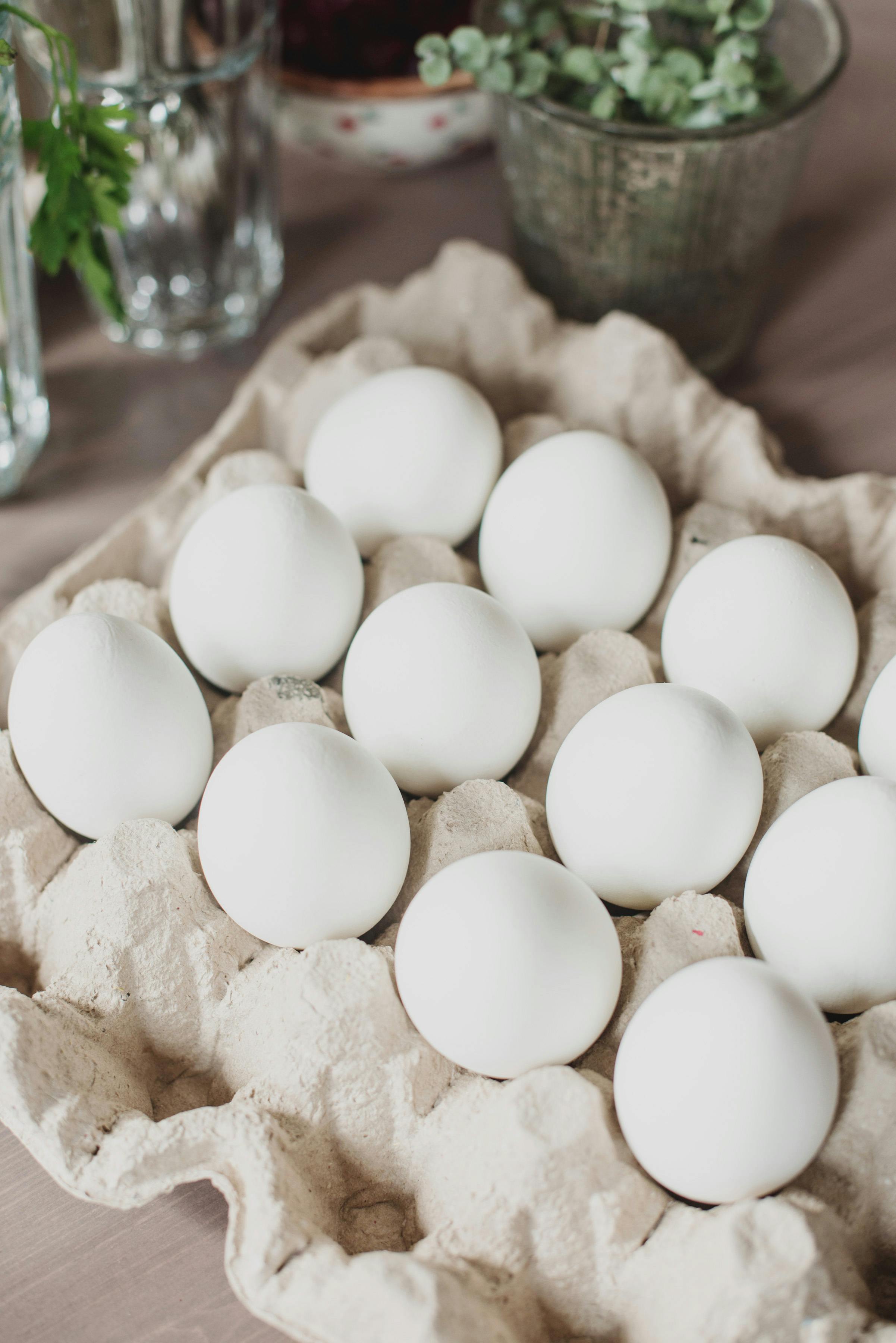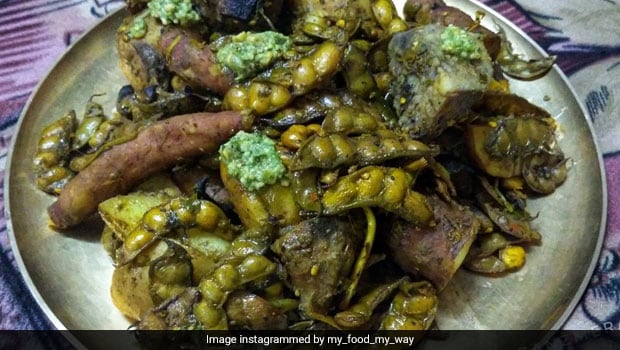This isn't one of those food pieces where I start off by waxing eloquent about my lifelong love for a particular dish - in this instance, the hyper-regional and winter seasonal Gujarati speciality called umbadiyu. In fact, up until a couple of months ago, I hadn't even heard of the all-vegetarian, green-hued, rustic dish also known as ubadiyu or to use a more local moniker 'Gujarati Barbeque'! It was an article on how the many stalls - dishing out the delicacy on the Mumbai-Ahmedabad highway at Dungri in south Gujarat - have been seeing no crowds due to the COVID-19 restrictions that introduced me to its wonders. I then promptly partook in a plate of the delicacy at a friend's home which was made lovingly for us by her grandmother.
Also Read: 6 Evergreen Gujarati Dishes You Must Try For A Wholesome Meal Experience

Umbadiyo shop in Valsad in Gujarat (Picture credit: Shikha Desai)
Over the last few weeks, I learned even more about this close cousin of the more popular matla undhiyu as I ogled at its drool-worthy images on the social media posts of an acquaintance. It was a chat with my friend, the national award-winning chef Varun Inamdar where I not only gleaned a lot more information on this rather elusive dish, but I also managed to wangle out his closely-guarded recipe for it.
What Is Umbadiyu Made Of?
Made with a mind-boggling array of vegetables and exotic-sounding vanaspatis (greens) like Indian nettle (kalhar) and black honey shrub, umbadiyu is a dish that requires a lot of preparation and time to make. It is baked in an upturned earthen pot called a 'matla' with dried dung cakes and sugarcane waste acting as the burning fuel.
What is the difference between Umbadiyu and Undhiyu?
Undhiyu and Umbadiyu are both winter vegetable dishes from Gujarat, but they differ in preparation and flavor. Undhiyu, meaning "upside down," is a mixed vegetable curry traditionally cooked in an inverted earthen pot. Modern versions are often made on a stovetop with more oil and spices, and include ingredients like fried fenugreek dumplings (muthia). Umbadiyu, also cooked in an earthen pot buried in a fire pit, is simpler with fewer spices, and its distinct smoky flavor comes from the slow-cooking process over cow dung cakes and hay. It's often found in rural areas of South Gujarat.
Where can you get umbadiyu?
Originally from Valsad in Gujarat, umbadiyu is available all across the winter season from late November to early February on the Mumbai-Ahmedabad highway, mainly condensed at the aforementioned village of Dungri. The delicacy has a rich, smoky aroma and taste. And though it uses fewer masalas than undhiyu, it is spicier and drier in texture. Always served with green chutney, pieces of boiled corn-on-the-cob and washed down with a glass of chaas.
Also Read: 5 Tips To Make Traditional Dal Dhokli At Home

Umbadiyo has a rich, smoky aroma and taste. (Picture credit: Shikha Desai)
How To Make Umbadiyu | Step-By-Step Umbadiyu Recipe
Recipe by chef Varun Inamdar, two times National Award winner
Ingredients:
- Green Paste
- 1 cup garlic cloves
- one-fourth cup ginger root
- 10 nos green chillies
- 1 tbsp turmeric powder
- 1 tsp salt
Marination (divided into two parts)
- Ginger-garlic-green chilly paste, as above
- 1 tbsp carom seeds
- 3 tbsp salt
- One-eighth of cup vegetable oil
- 1 tbsp turmeric powder
Ravaiyo (stuffing the brinjals)
- 500 gms brinjals, slit cross-wise
- Three-fourth cup peanut, roasted, peeled and crushed
- Half cup desiccated coconut
- One-fourth cup white sesame seeds, crushed
- 2 tbsp ginger-garlic green chilly paste, as above
- 1 tsp asafoetida powder
- 1 tbsp coriander powder
- Half tsp cumin powder
- 1 tsp salt
- 1 tsp turmeric powder
- 1 tbsp vegetable oil
Vegetables and beans
- 500 gms sweet potato, cut into 3-4 large pieces
- 500 gms potatoes, halved with skin on
- 500 gms purple yam, washed and cut into chunks
- 1 kg hyacinth beans in pods
- 500 gms field beans in pods
- 250 gms fresh sugarcane stalks (optional)
- 250 gms fresh peanuts
Vanaspati (Greens)
- It is incomplete without:
- Indian nettle/Kalhar
- Black honey shrub/Kamboi
- Lemon leaf/Limbda
- 7-8 nos Aakda na phool (Calotropis gigantean crown flower) (optional)
Method:
- Marinating: In a deep dish, take all the beans (keep 5 beans aside as per tradition) Add ginger-garlic-green chilly paste, carom seeds, salt, turmeric powder, 1 tbsp vegetable oil, 2-3 sprigs of kamboi leaves, 2-3 nos. kalhar leaves, 2-3 lemon leaves. Rub well for 3-4 minutes and keep aside. In another deep dish, take all root vegetables. Add the same ingredients again. Rub this also well for 3-4 minutes and keep aside.
- Stuffing the brinjals: In a bowl, take crushed peanuts, sesame seeds, desiccated coconut, ginger-garlic-green chilly paste, salt, turmeric powder, coriander powder, cumin powder, asafoetida powder and 1 tbsp vegetable oil. Mix well and stuff the same into the criss-cross cut brinjals and pack them back, nice and compact. This is called Ravaiyo Ringna in Gujarati. Keep aside.
- Packing it all up: Take an earthen pot and create a bundoo. Bundoo is a collection of assorted leaves (vanaspati) placed at the base. Add the marinated beans in two parts, at the base and the top, sandwiched with a layer of marinated root vegetables, stuffed brinjals and sugarcane stalks, and finally pack it all back with the assorted leaves. If using the flowers, disperse them onto the root vegetable mix.
- Upturning and cooking: Place the five beans that were kept aside, at the cooking site. Turn the pot onto those beans. After upturning the pot, it is covered with dried coconut leaves, sugarcane waste, dried cow dung cakes and dried mango leaves. This is lit and cooked for 45 minutes.
- Checking for doneness: The ash is moved aside, and the pot is upturned. The five beans that were kept under the pot must be cooked and that is the age-old style of testing the doneness of umbadiyu. These beans are called 'Sakshi' (if well-cooked) by the old makers. If they are uncooked, they are jokingly called 'Daakan', which means witch in Gujarati; and that means the cooking continues till it is well cooked.
- Serving: Discard the packing leaves and upturn onto a large platter. Serve with spicy green coconut chutney and chilled chaas (buttermilk).
Disclaimer: The opinions expressed within this article are the personal opinions of the author. NDTV is not responsible for the accuracy, completeness, suitability, or validity of any information on this article. All information is provided on an as-is basis. The information, facts or opinions appearing in the article do not reflect the views of NDTV and NDTV does not assume any responsibility or liability for the same.
About Raul DiasA Mumbai-based writer, Raul is an ardent devotee of the peripatetic way of life. When not churning out his food and travel stories at a manic pace, he can be found either hitting the road for that elusive story or in the company of his three dogs!









